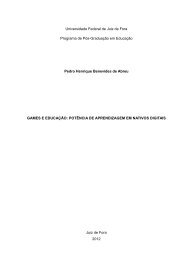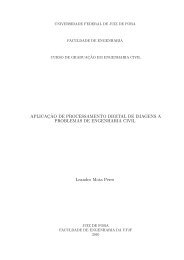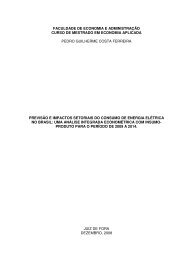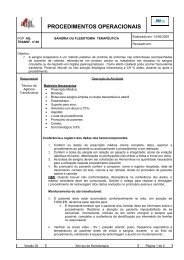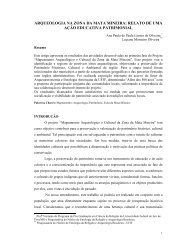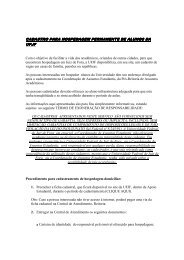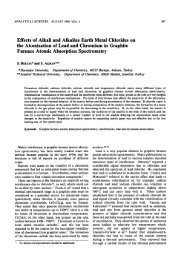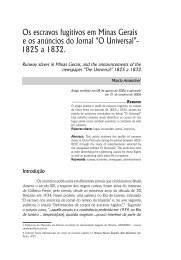Volume 6 | Número 2 Julho - Dezembro de 2012 - Universidade ...
Volume 6 | Número 2 Julho - Dezembro de 2012 - Universidade ...
Volume 6 | Número 2 Julho - Dezembro de 2012 - Universidade ...
You also want an ePaper? Increase the reach of your titles
YUMPU automatically turns print PDFs into web optimized ePapers that Google loves.
Psicologia em Pesquisa | UFJF | 6(02) | 160-170 | <strong>Julho</strong>-<strong>Dezembro</strong> <strong>de</strong> <strong>2012</strong><br />
apresentado (como produto final) pelo atleta, e<br />
a teoria do apego po<strong>de</strong> oferecer um insight sobre<br />
a origem do problema/evento antes mesmo do<br />
produto final. Em outras palavras, po<strong>de</strong> ajudar a<br />
prevenir tal comportamento a partir da antevisão<br />
da origem do comportamento em si, a partir<br />
da i<strong>de</strong>ntificação prévia do Mo<strong>de</strong>lo Interno <strong>de</strong><br />
Funcionamento do atleta. Por isso, i<strong>de</strong>ntificar o<br />
estilo <strong>de</strong> apego <strong>de</strong> um atleta po<strong>de</strong> potencialmente<br />
servir para antecipar o comportamento <strong>de</strong>ste não<br />
só diante <strong>de</strong> situações estressantes e <strong>de</strong>safiadoras,<br />
como uma competição <strong>de</strong> alto nível, mas também<br />
durante treinamentos <strong>de</strong> rotina. Isso, por sua<br />
vez, dá ao psicólogo do esporte a vantagem <strong>de</strong><br />
po<strong>de</strong>r moldar sua atuação nos procedimentos <strong>de</strong><br />
treinamento psicológico e <strong>de</strong> atuar <strong>de</strong> forma mais<br />
personalizada com seus atletas.<br />
Finalmente, o campo da teoria do apego<br />
ainda se encontra no estágio inicial <strong>de</strong> exploração,<br />
principalmente no Brasil, assim como a Psicologia<br />
Esportiva. Novos caminhos que explorem possíveis<br />
inter-relações entre esses dois campos <strong>de</strong> investigação<br />
po<strong>de</strong>m trazer benesses para a comunida<strong>de</strong> científica<br />
e leiga, assim como contribuições promissoras para<br />
uma melhor atuação <strong>de</strong> acadêmicos e profissionais<br />
da Psicologia Esportiva. Espera-se, portanto, que esta<br />
iniciativa teórica inspire também outros pesquisadores<br />
a contribuírem com futuras investigações e produções<br />
nesse domínio.<br />
Referências<br />
Ainsworth, M. D. S. (1989). The <strong>de</strong>velopment of infantmother<br />
attachment. In B. Caldwell & H. Ricciuti<br />
(Eds.), Review of Child Development Reasearch, (pp.<br />
1-94). Chicago: University of Chicago Press.<br />
Ainsworth, M. D. S., Blehar, M. C., Waters, E.,<br />
& Wall, S. (1978). Patterns of attachment: a<br />
psychological study of the strange situation.<br />
Hillsdale (NJ): Lawrence Erlbaum.<br />
Atilli, G. (2001). Ansia da Separazione e Misura<br />
<strong>de</strong>ll’Attacamento Normale e Patologico. Milano:<br />
Unicopli.<br />
Atilli, G., Vermigli, P., & Roazzi, A. (2011). Rearing<br />
Styles, Parents’ Attachment Mental State, and<br />
Children’s Social Abilities: The Link to Peer<br />
Acceptance. Child Development Research, 1-12.<br />
Belch, E. G., & Belch, M. A. (2004). Advertising and<br />
Promotion (6 ª Ed.). Boston: McGraw-Hill.<br />
Blythe, J. (1997). The Essence of Consumer Behaviour.<br />
Harlow: Prentice-Hall.<br />
Bowlby, J. (1969). Attachment and loss: Vol. I. London:<br />
Hogarth Press.<br />
Bowlby, J. (1973). Attachment and loss: Vol. II.<br />
London: Hogarth Press.<br />
Bowlby, J. (1980). Attachment and loss: Vol. III.<br />
London: Hogarth Press.<br />
Bradford, E., & Lyddon, W. (1994). Assessing<br />
Adolescent and Adult Attachment: An Update.<br />
Journal of Counseling and Development, 73(2),<br />
215-219.<br />
Carr, S. (2009). Implications of attachment theory<br />
for sport and physical activity research: conceptual<br />
links with achievement goal and peer-relationship<br />
mo<strong>de</strong>ls. International Review of Sport and Exercise<br />
Psychology, 2(1), 95-115.<br />
Cilo, E. N. P. (2002). Psicologia do esporte: conceitos<br />
aplicados a partir da Análise do Comportamento. In<br />
A. M. S. Teixeira (Ed.), Ciência do Comportamento:<br />
conhecer e avançar, (pp. 119-137). Santo André:<br />
ESETec.<br />
Cohn, D. A., Cowan, P. A., Cowan, C. P., & Pearson,<br />
J. (1992). Mothers’ and fathers’working mo<strong>de</strong>ls<br />
of childhood attachment relationships. Parenting<br />
styles and child behavior. Development and<br />
Psychopathology, 4, 417-431.<br />
Corriveau, K. H., Harrys, P. L., Meins, E.,<br />
Fernyhough, C., Arnott, B., Elliot, L., Liddle, B.,<br />
Hearn, A., Vittorini, L., & Rosnay, M. (2009).<br />
Young children’s trust in their mother’s claims:<br />
longitudinal links with attachment security in<br />
infancy. Child Development, 80(3), 750-761.<br />
Dalbem, J. X., & Dell’Aglio, D. D. (2008). Apego<br />
em adolescentes institucionalizadas: processos <strong>de</strong><br />
resiliência na formação <strong>de</strong> novos vínculos afetivos.<br />
PSICO, 39(1), 33-40.<br />
Dalbem, J. X., & Dell’Aglio, D. D. (2006). Teoria<br />
do apego: bases conceituais e <strong>de</strong>senvolvimento<br />
dos mo<strong>de</strong>los internos <strong>de</strong> funcionamento. Arquivos<br />
Brasileiros <strong>de</strong> Psicologia, 57, 2006. Acesso em 30<br />
<strong>de</strong> Agosto <strong>de</strong> 2010, em http://redalyc.uaemex.mx/<br />
redalyc/pdf/2290/229017444003.pdf<br />
Davis, D., Shaver, P. R., & Vernon, M. L.<br />
(2003). Physical, Emotional, and Behavioral<br />
Reactions to Breaking Up: Roles of Gen<strong>de</strong>r,<br />
Age, Emotional Involvement, and Attachment<br />
Style. Personality and Social Psychology Bulletin,<br />
29(7), 871-884.<br />
Silva M. A. 168



